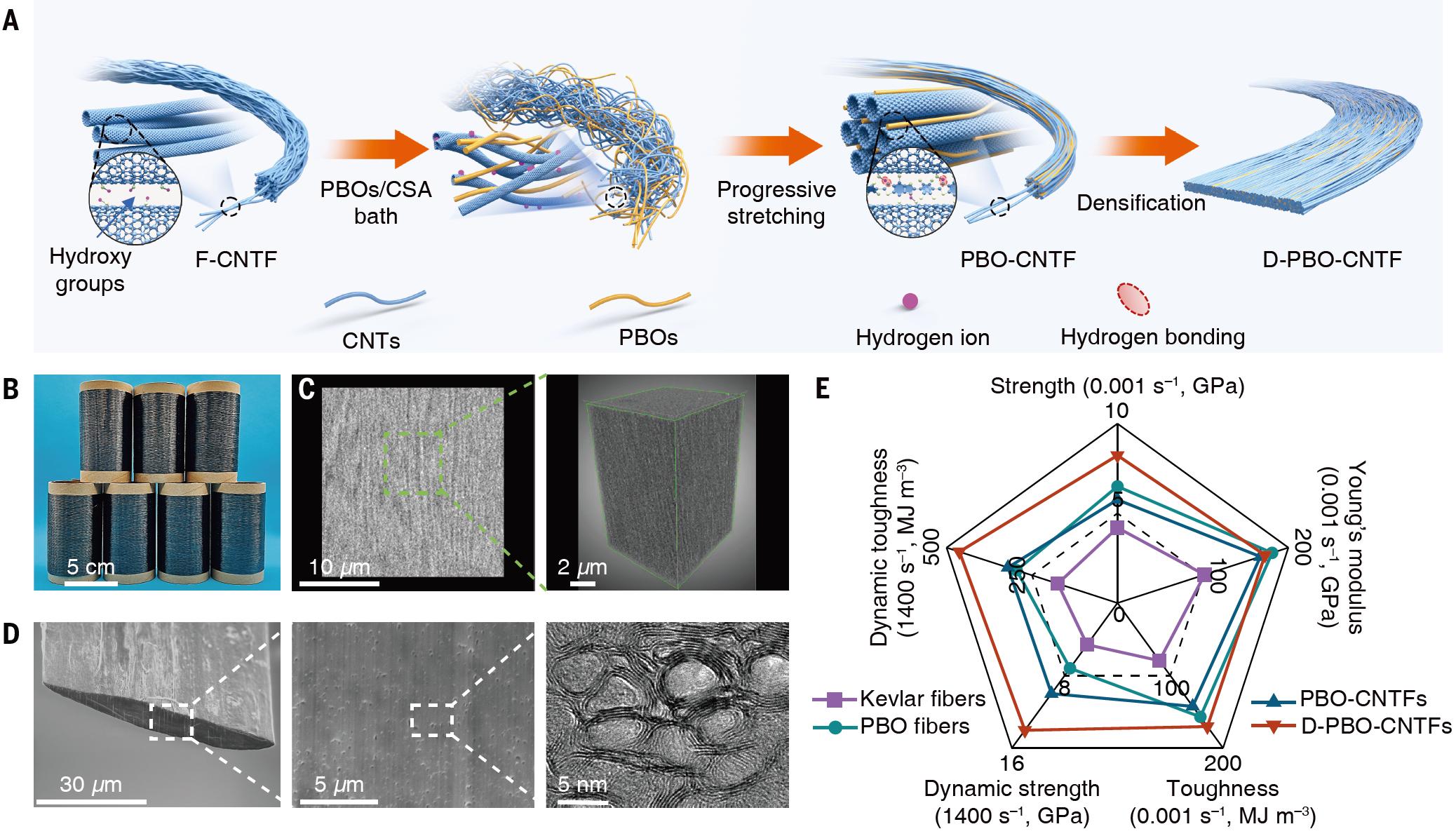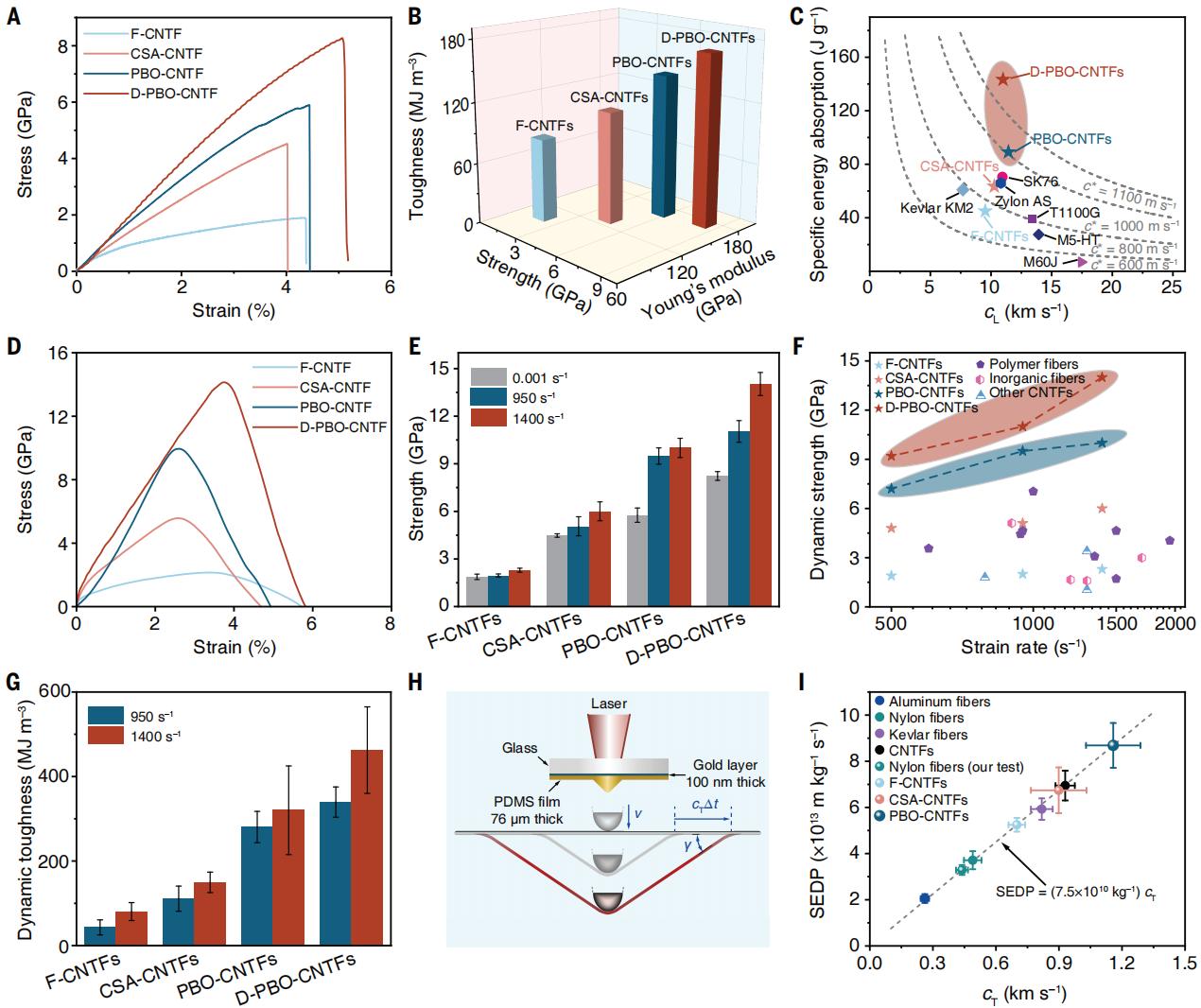Prof. ZHANG Jin and Assoc. Prof. JIAN Muqiang from Peking University and the Beijing Graphene Institute, Prof. WU Xianqian from the Institute of Mechanics, Chinese Academy of Sciences, Assoc. Prof. GAO Enlai from Wuhan University, Prof. ZHANG Yongyi from the Suzhou Institute of Nano-Tech and Nano-Bionics, Chinese Academy of Sciences and collaborators developed a strategy to fabricate carbon nanotube fibers with dynamic strength up to 14 GPa. This work has been published in Science with the title of “Carbon nanotube fibers with dynamic strength up to 14 GPa” on June 21.
High-performance fibers with lightweight, high dynamic strength and excellent energy absorption capability are persistently required for high-strain-rate application scenarios such as battlefield protection and space debris capture. Carbon nanotubes that possess excellent properties including lightweight, strong, high modulus, highly electrical and thermally conductive are considered as one of ideal building blocks for the next generation of high-performance fibers, promising to meet the needs of high-strain-rate applications. However, due to the issues of fiber assembly structure, the tensile strength of carbon nanotube fibers remains below 10 GPa, far below their ideal strength, indicating substantial room for improvement.
They therefore proposed an innovative multi-scale structural optimization strategy to systematically optimize the interfacial interactions, nanotube alignment, and densification of carbon nanotube fibers. This has resulted in dynamic strength reaching up to 14 GPa, breaking the existing strength record for fibers. Firstly, the carbon nanotube fibers produced by floating catalyst chemical vapor deposition were purified and functionalized. Then, the fibers were subjected to progressive stretching in a chlorosulfonic acid (CSA) solution containing poly(p-phenylene-2,6-benzobisoxazole) (PBO), followed by mechanical densification. This strategy leads to improvements in interfacial interactions, nanotube alignment, and densification within the fibers. (Fig. 1), achieving a breakthrough in both quasi-static and dynamic strength.

Fig. 1. Preparation, morphology, and mechanical properties of CNTFs. (A) Strategy to develop highly packed and well-aligned CNTFs. (B) Digital photograph of PBO-CNTF tows. (C) Three-dimensionally reconstructed void microstructure (right) derived from nano-CT results (left) for D-PBO-CNTFs. (D) SEM (left and middle) and TEM (right) images of the radial cross section of D-PBO-CNTF cut by a focused ion beam. (E) Radar chart for comparing the mechanical performance of different CNTFs and commercial fibers (PBO and Kevlar 29 fibers). (Image by PKU, BGI, IMECH, WHU and SINANO)
The ordered assembly of carbon nanotubes endows the fibers with excellent mechanical properties. The quasi-static strength of the carbon nanotube fibers reaches 8.2 GPa, and the Cunniff velocity that used to evaluate its ballistic performance exceeds 1100 m/s (Fig. 2A-C). To disclose the impact protection performance of the carbon nanotube fibers, a mini-split Hopkinson tension bar was employed to measure the mechanical behavior of the fibers under high-strain-rate loading. The results indicated that as the tensile rate increased, the fibers experienced a transition from ductile to brittle failure behavior, rendering the fibers significant strain-rate-strengthening effects. When the strain rate was approximately 1400 s–1, the dynamic strength of the fibers reached up to 14 GPa, surpassing all other high-performance fibers (Fig. 2D-G). Furthermore, a laser-induced high-velocity transverse-impact testing was built to investigate the dynamic response of the fibers under simulated ballistic impact loading. The result showed that the specific energy dissipation power of the fibers reached (8.7 ± 1.0) × 1013 m kg–1 s–1, far exceeding that of traditional bulletproof fibers such as Kevlar (Fig. 2H-I). These results indicate that carbon nanotube fibers have great potential for application in impact protective engineering.

Fig. 2. Mechanical properties of CNTFs. (A) Quasi-static stress-strain curves of F-CNTFs, CSA-CNTFs, PBO-CNTFs, and D-PBO-CNTFs. (B) Comparison of quasi-static tensile strength, Young’s modulus, and toughness of different CNTFs. (C) Comparison of specific energy absorption and longitudinal wave velocity of our fibers (indicated by stars) and other high-performance fibers. (D) Stress-strain curves of F-CNTFs, CSA-CNTFs, PBO-CNTFs, and D-PBO-CNTFs at high strain rates of about 1400 s–1. (E) Comparison of the strength of CNTFs at different strain rates. Error bars indicate the standard deviation of the means of independent measurements. (F) Comparison of the dynamic strength of our fibers and other high-performance fibers at high strain rates. (G) Comparison of the dynamic toughness of CNTFs at different strain rates. Error bars indicate the standard deviation of the means of independent measurements. (H) Schematic diagram of laser-induced high-velocity transverse impact on a single fiber. Here, PDMS, v, Δt, and γ represent polydimethylsiloxane, impact velocity, interval time, and deflection angle, respectively. (I) SEDP values of different fibers. Error bars indicate the standard deviation. (Image by PKU, BGI, IMECH, WHU and SINANO)
The synergistic enhancement of interfacial interactions, nanotube alignment, and densification of carbon nanotube fibers is crucial for their excellent mechanical properties. In-situ Raman testing and molecular dynamics simulations indicated that strong interactions between PBO and carbon nanotubes enhance intertube interactions and stress transfer (Fig. 3A and B). Coarse-grained simulation results suggested that during progressive stretching, the addition of PBO reduces fiber porosity, increases density, and decreases stress concentration (Fig. 3C). Under high-speed loading conditions, a higher proportion of carbon nanotubes in the fibers break, and the fiber fracture mode transitions from intertube sliding to more synchronous carbon nanotube fractures (Fig. 3D-G), thereby endowing the fibers with superior dynamic mechanical properties.

Fig. 3. Mechanistic analyses of the dynamic performance of CNTFs. (A) Dependence of Raman frequency downshifts on the applied strains for F-CNTFs and PBO-CNTFs. (B) Stress-relaxation curves of different fibers at 1.5% strain. (C) Simulation snapshots of progressive stretching treatment for CNTFs with and without PBO. (D) Structures and cross-sectional morphology of the simulated model. (E) Snapshots of deformed D-PBO-CNTFs under low (left) and high (right) loading velocities. The atoms are colored according to the bond strain. (F) Stress-strain curves of CSA-CNTFs and D-PBO-CNTFs under low and high loading velocities. (G) Percentage of broken CNTs for CSA-CNTFs and D-PBO-CNTFs during the tensile process, which is counted up to the peak stress in the stress-strain curves. (Image by PKU, BGI, IMECH, WHU and SINANO)
Contact:
CHEN Yuying
Institute of Mechanics Chinese Academy of Sciences Chinese Academy of Sciences
Tel: 86-10-82544075
E-mail: chenyuying@imech.ac.cn